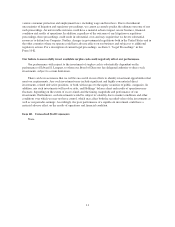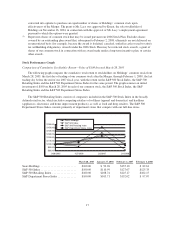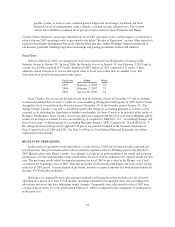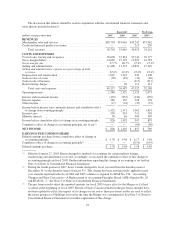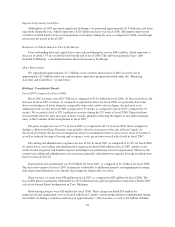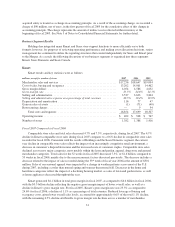Sears 2007 Annual Report Download - page 21
Download and view the complete annual report
Please find page 21 of the 2007 Sears annual report below. You can navigate through the pages in the report by either clicking on the pages listed below, or by using the keyword search tool below to find specific information within the annual report.Item 7. Management’s Discussion and Analysis of Financial Condition and Results of Operations
We have divided our “Management’s Discussion and Analysis of Financial Condition and Results of
Operations” (“MD&A”) into the following five sections:
• Overview of Holdings and Fiscal Year
• Results of Operations:
Fiscal 2007 Summary
Holdings’ Consolidated Results
Business Segment Results
Pro Forma Reconciliation
• Analysis of Consolidated Financial Condition
• Contractual Obligations and Off-Balance Sheet Arrangements
• Application of Critical Accounting Policies
Overview of Holdings
Holdings, the parent company of Kmart and Sears, was formed in connection with the March 24, 2005
Merger of these two companies. We are a broadline retailer and, at the end of fiscal 2007, had 2,317 Kmart and
domestic full-line stores and 1,150 specialty retail stores in the United States operating through Kmart and Sears
and 380 full-line and specialty retail stores in Canada operating through Sears Canada, a 70%-owned subsidiary.
We currently conduct our operations in three business segments: Kmart, Sears Domestic and Sears Canada.
Prior to the Merger, we operated a single business segment, Kmart. The nature of operations conducted within
each of these segments is discussed within the “Business Segments” section of Item 1 in this Form 10-K.
The retail industry is highly competitive and as such, Holdings faces significant challenges to achieve
prominence. However, we believe that we posses unique resources with which we can differentiate ourselves
from our competitors. These resources include:
• The brands we own (Kenmore, Craftsman, DieHard, and Lands’ End) are one of our most important
resources. We believe that each of these four brands has significant recognition and value with
customers.
•Home services, including installation, delivery, and repair, represent another important resource of our
Company. Our extensive network of in-home and in-store service businesses gives us the opportunity
to retain long-term relationships with our customers—a chance to deliver value not only at the point of
sale but also on an ongoing basis, and a chance to learn continuously about our customers and what
they like and do not like about our products.
• Our existing store base is another resource, as our more than 3,400 domestic stores provide us with a
physical presence in almost all major communities in the United States.
• We also have viable on-line businesses, which enhance our multi-channel customer experience.
Sears.com, Landsend.com and PartsDirect.com are examples of on-line channels where we engage and
transact with our customers. We are investing in these on-line capabilities, as we believe that a
compelling multi-channel experience will be an important factor for success in the years and decades to
come.
In addition to these resources, we believe that we have a solid balance sheet, with capacity to secure additional
debt if necessary. We own substantial inventory and real estate assets, and have also reduced our consolidated
debt to $2.3 billion ($3.0 billion with capital leases), which we consider low in relation to both our cash flow
generation and market capitalization.
21


